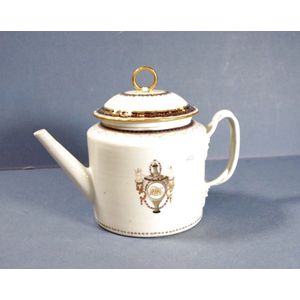Wedgwood Redware Teapot with Jackfield Glaze and Gilt Decoration
You must be a subscriber, and be logged in to view price and dealer details.
Subscribe Now to view actual auction price for this item
When you subscribe, you have the option of setting the currency in which to display prices to $Au, $US, $NZ or Stg.
- Jackfield Glaze - A Jackfield glaze is a ceramic glaze that is typically black and highly lustrous. It is often used on stoneware or porcelain pottery to create a dramatic effect. The glaze is named after the town of Jackfield in Shropshire, England, where it was first developed in the 18th century.
The glaze is made by mixing various metal oxides, such as iron oxide and manganese dioxide, with a lead-based frit, which is a mixture of raw materials that have been melted and then quenched to form a glass. The glaze is then applied to the pottery and fired at a high temperature in a kiln.
Jackfield glaze is known for its unique properties, including its ability to create a highly reflective surface that resembles the appearance of black glass. The glaze is also quite durable and resistant to scratching and chipping, which makes it a popular choice for functional pottery such as bowls and plates. However, due to the use of lead in the frit, Jackfield glaze is not recommended for use on pottery that comes into contact with food or drink.
This item has been included into following indexes:
Visually similar items

A French silver teapot, early 20th century, with rubbed Minerva and maker's marks, the ovoid pot with a tapering neck, having a low domed lid with a beaded edge, the finial conforming, a slender fluted and foliate spout and an Empire style bracket timber h

Victorian sterling silver teapot of oval part fluted form, London 1881

A fine Victorian sterling silver teapot in the Gothic taste, 1872 London, with maker's mark for Richard Hodd and Richard Hodd II, the oval straightsided pot with a low domed lid and a mushroom styled finial, having a 'C' form handle with ivory insulators a

Chinese export porcelain coffee pot, blue decoration on white ground with gilt highlights. Double entwined handle (restored). Monogram to sides. Lid is non matching height 19 cm.
